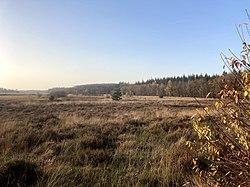Drenthe
Drenthe (pronounce: "DREN-te") is a province in the northeast of the Netherlands. The capital city is Assen. South of it is Overijssel, west of it is Friesland and north of it is Groningen. East of it is Lower Saxony, that is a part of Germany. About 502,000 people are living in Drenthe (2023).
Drenthe | |
|---|---|
Province | |
 Boswachterij Grolloo (municipalities of Aa en Hunze and Midden-Drenthe) | |
 Location | |
 Map | |
| Coordinates: 52°52′N 6°38′E / 52.867°N 6.633°E | |
| Country | Netherlands |
| Established | 1815 |
| Seat | Assen |
| Area | |
| • Total | 2,680 km2 (1,030 sq mi) |
| • Land | 2,633 km2 (1,017 sq mi) |
| • Water | 48 km2 (19 sq mi) |
| Highest elevation | 27 m (89 ft) |
| Lowest elevation | −2 m (−7 ft) |
| Population (2023) | |
| • Total | 502,000 |
| • Density | 191/km2 (490/sq mi) |
| Website | www |
History
changeThousands of years ago, there were already people in Drenthe. Around 3500 BC people made dolmens (hunebedden), piles of big stones. 53 of the 54 dolmens in the Netherlands are in Drenthe. Most of them are in the northeast of the province.
The oldest paper with the name Drenthe on it is from 820. It was called Pago Treanth (district Drenthe). Papers from 1024 and 1025 show that is was a county at that time.
From 1046 until 1528, the bishops of Utrecht ruled over Drenthe. From 1581 until 1795 it was part of the Republic of the Seven United Provinces, but Drenthe itself was not a province. In 1796, under the Batavian Republic, Drenthe was a province for the first time.
In the Second World War, the nazis build a concentration camp near Westerbork. From there, they put Dutch Jews on the train to other camps in Germany and Poland. In the last train from Westerbork was also Anne Frank. She was a Jewish girl and she wrote a diary. She died in the concentration camp Bergen-Belsen in Germany. After the war her diary became world famous.
Municipalities
changeLocation of the municipalities of Drenthe.
Geography
changeThe most important[source?] cities are Assen (the capital), Emmen, Meppel and Hoogeveen. In Drenthe there is many heathland.
Dialects
changeIn Drenthe many people speak Low Saxon dialects. The dialects in Drenthe are called Drents. These dialects are different in each town or village.
| Drents in Emmen: | We moet'n nie zo haas'n'n. (Dutch: We moeten niet zo haasten. English: We do not have to hurry). |
| Drents in Ruinen: | een, tweej, drai, vier, vaif, zees, zeeve, aach, neuge, tein. (1,2,3,4,5,6,7,8,9,10). |
| Drents in Noordenveld: | ain, twai, drai, vaier, vief zes, zeum, aacht, neegn, tien. (1,2,3,4,5,6,7,8,9,10). |
| Drents in Ruinerwold (about 10 km from Ruinen): | iene, tweie, dreie, veere, vieve, zesse, zeum, achte, neegn, tiene. (1,2,3,4,5,6,7,8,9,10). |
Related pages
changeOther websites
change

